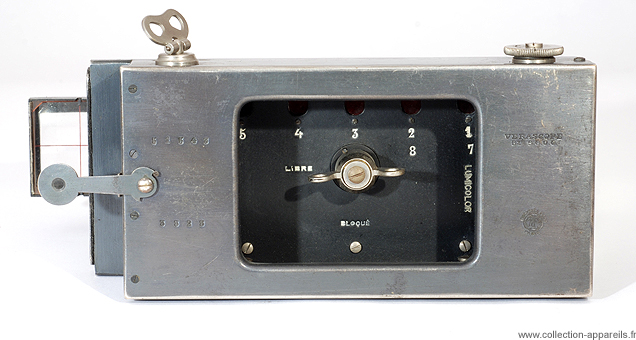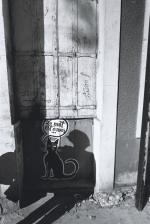|
Richard Jules Vérascope |
Manufactured or assembled in France from 1928 to (After) 1928.
Index of rarity in France: Rare (among non-specialized garage sales)
Inventory number: 16024
See the complete technical specifications
Chronology of cameras Richard Jules
Félix Richard was born in Lyon in 1809 from an old family of silk producers. He became a precision instrument maker and optician on Quai Saint-Antoine. In 1855, he moved to Paris and led a significant industry manufacturing barometers and pressure gauges. He served as a member of the government in 1870 and as the mayor of the 19th arrondissement. However, he neglected his business, and upon his death on July 14, 1876, his company was burdened with debt.
Félix-Max and Jules took over the company under the name Richard Frères (hence the acronym "RF"). In 1888, their brother Georges joined them until 1891. Jules then bought out his brothers' shares but retained the company name. Jules passed away at the age of 82 on June 18, 1930, holding the title of Commander of the Legion d'Honneur, a well-deserved recognition for his industrial activities, involvement in stereoscopy, and the establishment of an apprenticeship school.
As a passionate photographer, Jules Richard constructed a revolutionary stereoscopic camera in 1893. He was the first to understand the necessity of having lenses spaced apart to recreate a perspective that "renders the image in true size with depth." Another innovation was his adoption of a tiny format for the time, 4 cm by 4 cm, while the average amateur regularly used 13 cm by 18 cm.
Advocating for the small format, which was commercially successful, Jules nonetheless offered a series of Homéoscope cameras (1895-1904) to satisfy his friends and provide them with a high-quality camera in their preferred format, available in 8 cm by 9 cm and 6 cm by 6.5 cm, with or without a magazine, but in very limited quantities. Despite its initial simplicity, the Vérascope was an expensive camera due to its precision craftsmanship. To popularize stereoscopy in his favored format, Jules Richard introduced the Glyphoscope in 1905. Interestingly, three models were offered with the same technical specifications. In 1908, a special model for film packs was released. In 1927, a 6 cm by 13 cm model was introduced, which would have slow speeds by 1930. The façade of the Glyphoscope was detachable, allowing it to be used as a viewer.
In 1905, to satisfy the members of the Stéréo-Club de France, he offered a Vérascope in a 7 cm by 13 cm format, the maximum allowed by the interocular distance. Price and competition would reduce the sales of these models, but various increasingly sophisticated variants were still offered. A simplified model was presented in 1923, and in 1928, the Vérascope adopted the 6 cm by 13 cm format. In 1913, Jules patented the Homéos, the first stereoscopic camera using 35 mm cine film, but it was not available for purchase until 1920. He reaffirmed his interest in the small format, with the resulting images measuring 18 mm by 24 mm.
In 1931, the Stéréa 6 cm by 13 cm was offered in two versions, varnished wood or metal, but with the same technical specifications. Positioned between the Vérascope and the Glyphoscope, they entered a crowded market. In 1939, the Vérascope 40 was patented, using 35 mm film with a new image format, 24 mm by 30 mm, which would remain distinctly French. This modern camera was distributed in the USA by the Bush company.
(N° 48570 équipé d’un dos film N° 51543 - 3323)
C'est un modèle perfectionné, mais de format 6 x 13, avec mise au point par hélicoïdes commandées par une biellette.
Diaphragmes iris couplés : 4,5 5,6 8 11 16 23 32. Objectifs "Tessar Zeiss 1:4,5 f-8,5cm Bté E. Krauss Paris N° 148031 et 148025". Viseur de poitrine redresseur et viseur optique pliant. Niveaux à bulle dessus et dessous. Armement par papillon en façade,
Il y a un sélecteur Pose et Instantané et les vitesses sont graduées : 8 14 28 55 117 166. Chaque obturateur dit "Chronomos" était mesuré et gradué individuellement.
Le boîtier est rallongé, pour recevoir des magasins à plaques permettant de changer facilement les douze plaques en une seule manœuvre, ces nouveaux magasins étant identiques dans leur principe à ceux de Cornu.
Le verrou est d’un modèle nouveau.


Interesting links or bibliography :
Add a link or element of bibliography, a picture taken with this camera, a picture of box or an ads about this camera
Your photos taken with the same camera:
Cameras from Ebay France (Richard Jules) (Uploaded each 3 hours)








